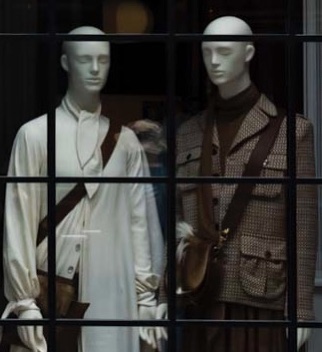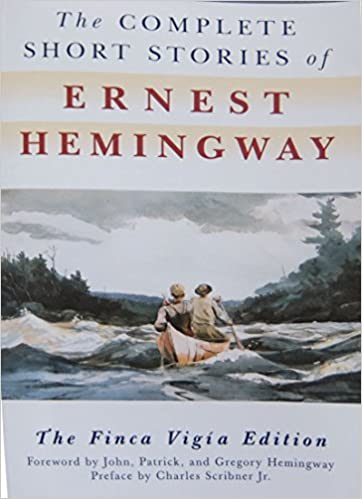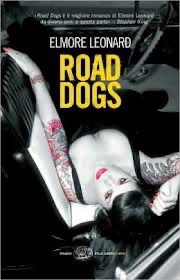Mannequin Monday – Let His Characters Speak

A defining characteristic of Ernest Hemingway’s writing style: “His decision to let his characters speak.” So says writer Justin Rice on Hemingway’s use of dialogue.
This week I also look at Elmore Leonard. He writes dialogue rich in action and light on description.
And I offer another sample of my own writing, my own attempt at writing decent dialogue.
This Week’s Story
This week I’ve been reading some of Ernest Hemingway’s short stories. In doing a Google search for background info on his work, I came across Justin Rice’s 2016 article “What Makes Hemingway Hemingway?”. Rice does an informative statistical analysis of Hemingway’s style. The article is worth reading, especially if you enjoy comparative literature. You can read the entire article here, or Download this! (PDF). I’ll take note of a few points here.
Rice says what many writers already know. “What defines Hemingway’s style—short sentences, short words, lots of dialogue, lots of repetition.”
And in regard to Hemingway’s use of dialogue, Rice says, *What really sets him apart from his admirers is his decision to let his characters speak.”
Here’s a short excerpt from Hemingway’s 1939 short story, “Under the Ridge.” During the Spanish Civil war, several American soldiers, just returned from the fighting, listen to other soldiers who have been held in reserve for another battle. They are all sharing wine.

“There is no thirst like the thirst of battle. Even here, in reserve, I have much thirst.”
“That is fear,” said another soldier. “Thirst is fear.”
“No,” said another. “With fear there is thirst, always. But in battle there is much thirst even when there is no fear.”
“There is always fear in battle,” said the first soldier.
“For you,” said the second soldier.
“It is normal,” the first soldier said.
“For you.”
“Shut your dirty mouth,” said the first soldier. “I am simply a man who tells the truth.”
Hemingway, in this part of his story, offers no descriptions of either setting or characters. He relies entirely on dialogue, He simply lets his characters speak.
Another author renowned for writing dialogue is Elmore Leonard. In her 2013 article “Dialogue Tips I Learned from Reading Elmore Leonard,” Carol Despeaux Fawcett comments on Leonard’s use of dialogue. She first cites an excerpt from his book Road Dogs as an example:
“You and the wife,” Foley said, “devoting your lives to caring for people.”
“Is the reason we fall in love with each other. We alike in how we know how to make people happy.”
“But running a psychic con,” Foley said, “doesn’t mean she’s actually psychic.”
“She saw me in the fucking courtroom, didn’t she?”
“She as cool as Megan Norris?”

“They both cool, but in different ways. Miss Megan is cool because she smart, man, always knows what to say. Dawn is cool because she knows what you going to say.”
“They must be a lot different,” Foley said, “in how they see things.”
“Tha’s what I just tole you, they different.”
“Megan asked me how could I stand to throw away some of my best years in a dump like this. She wanted to know why I didn’t get in a prison rehab program. Learn how to grow sugarcane.”
“Burn the field you ready to go in and cut the cane, these poison snakes in there eating rats, man, they come at you. Hey, fuck that. You tell her God made you a bank robber?”
“I think she knew it.”
“The way I see you, Jack, you smart, you can be a serious guy, but you don’t like to show anything is important to you. You here, you don’t complain—not anymore—you could be an old hippie living here. You get your release…Ah, now you get to think what you going to do.”
“I’ve been reading about Costa Rica,” Foley said. “Go down there and start over.”
“Yes, someday, uh? You want me to tell you,” Cundo said, “you leave here, the first thing you going to do?”
“Rob a bank.”
“See? Is already on your mind.”
“It’s on your mind, not mine.”
“How you gonna get to Costa Rica?”
Fawcett explains, “Leonard uses dialogue tags infrequently, only when necessary or when he wants a break in the back and forth dialogue. The two men speak differently enough that it’s clear who is saying what. He also uses few interruptions like visceral responses or body language cues. I believe this is because his dialogue is so strong he doesn’t need them and he didn’t want to slow down the pace.”
Lessons in writing dialogue for all writers, new and experienced.
My Current Writing
As part of my writing course with the University of Iowa, I pulled an excerpt from my 2014 novel Apart and re-wrote it. I added a third character and changed up the pace of the dialogue to match each character. Enjoy!
We join three people at a Starbucks café. Cabe Wray, a sales rep in his early sixties. Turo Fonseca, a young filmmaker. Kelsey Graf, a young actress/filmmaker.
“Searching for forty years, man.” Turo leaned in. “Tell me why you want to do this.”
Cabe said, “I’m convinced she’s still alive.”
Turo sipped his iced tea, screwed up his face. “Panther piss.” He held up a finger for Cabe to pause, got up to get several packets of sugar, and poured them into his cup.

Kelsey said to Cabe, “I’m missing something. Your twin sister disappeared forty years ago. We’re not investigators. What can we do that you haven’t already done?”
“Make a video I can post online.”
Turo reached into his messenger bag. “I brought a DVD disk with two samples of my work for you to look at.” He pushed the disk sleeve across the table to Cabe. “Kelsey, you’ve seen these before.”
He pushed his drink out of the way, turned his iPad so Cabe could see the screen.
“Here’s one of my short films. Underground in New York City. The story resonates urban reality. Take a few minutes now…”
Cabe waved his hand. “What kind of resources do you have here in LA?”
Turo nodded to Kelsey. She said, “What do you want this video to say?”
Cabe sipped his coffee. Pointed his cup at the two. “That’s why I need your help.”
Kelsey shook her head. “If I may wax poetic, how many years can a man search before he loses himself?”
Cabe met her eyes, looked down to peel the paper sleeve off his cup. “I have to do this.”
Turo said, “Tell us what you’ve done to search for her all these years.”
“My search methods don’t match today’s technology. That’s what my friend Mark told me.”
“Mark told me you quit your job.”
Cabe shrugged. “What do you need to know from me about doing this video?”
Turo lowered his voice. “What’s her name?”
“Gail Wray… at least, it was.”
What’s her name?
“Gail Wray. A fairly unique name… Do you think she would still look much like you do now?”
“I guess so. At least she’d probably have the same overall build.”
“Aging software?” Kelsey said to Turo.
“Better…we re-create the past.”
“You’re losing me,” Cabe said.
Kelsey leaned back, smiled. “Yes. I can play Gail as she was forty years ago. Animate her memory.”
Turo gestured to Kelsey, said to Cabe, “We want this job. We can find her.”
***
Thanks for reading, and comments are always welcome. See you next week.
Leave a Reply